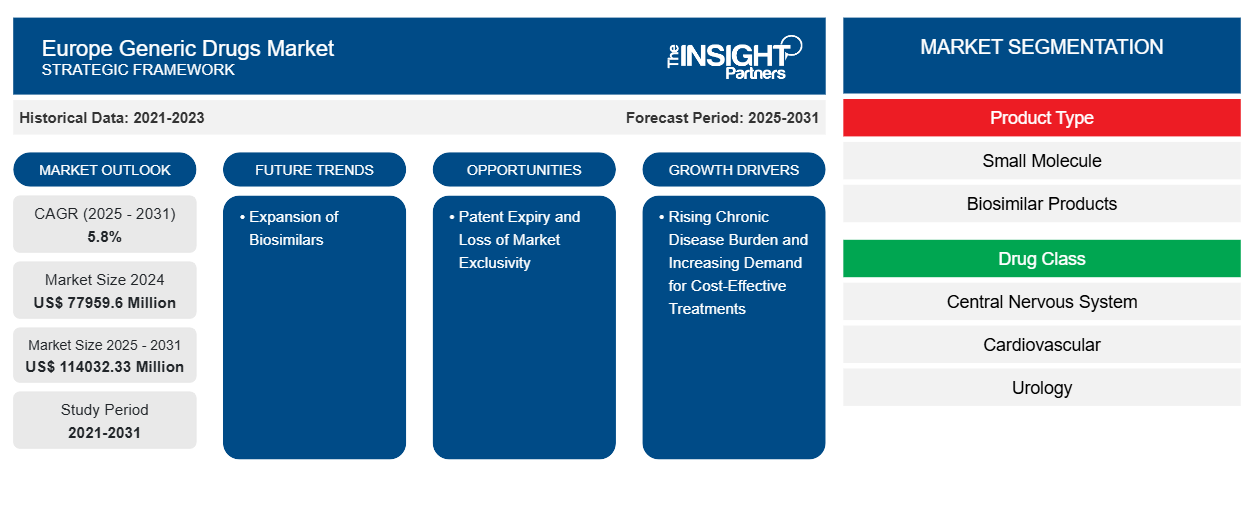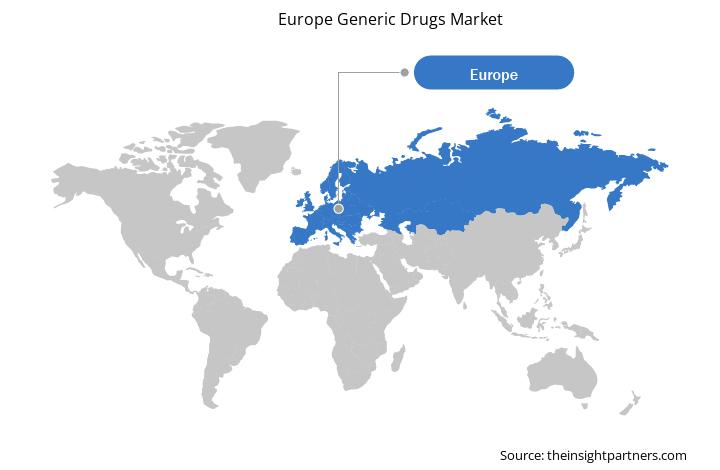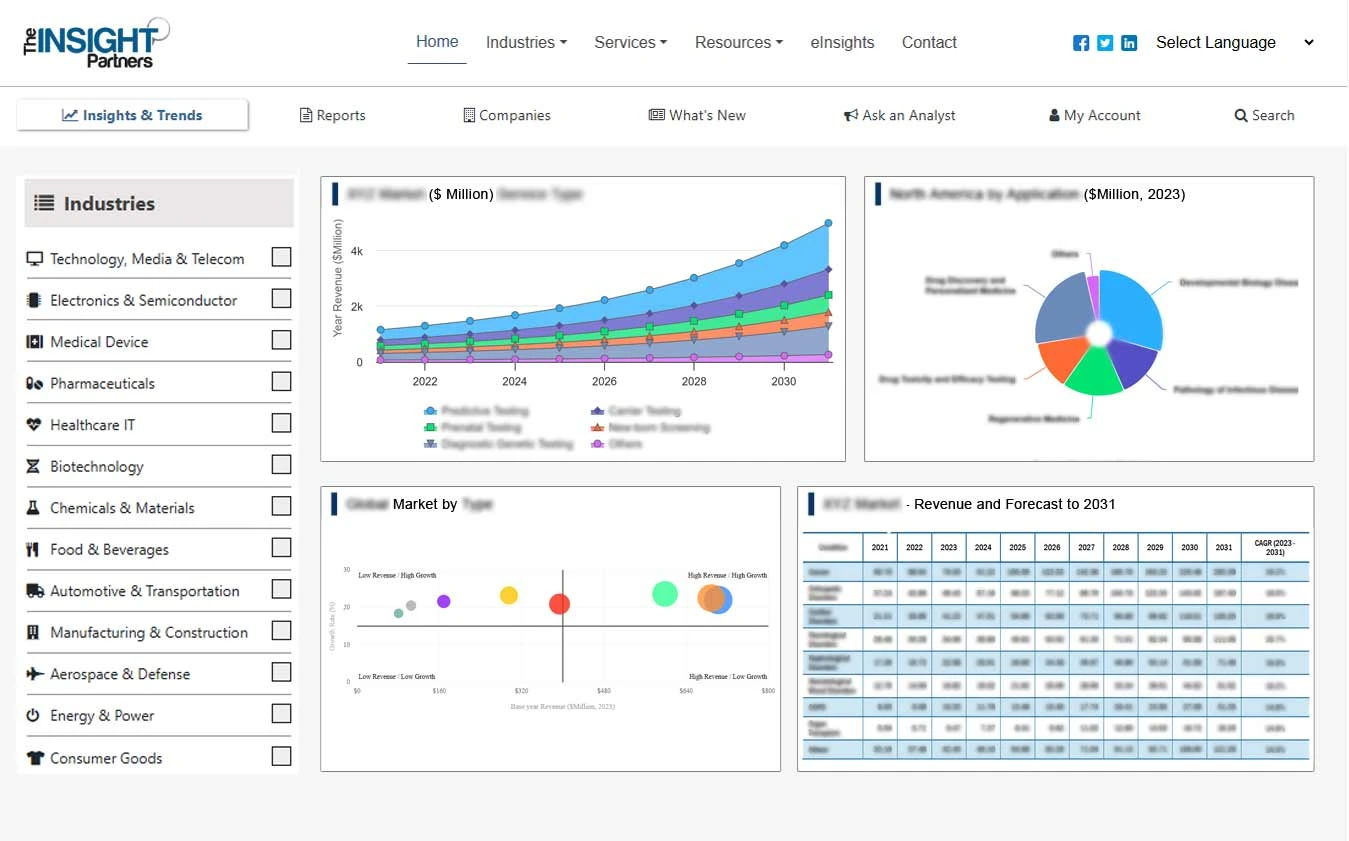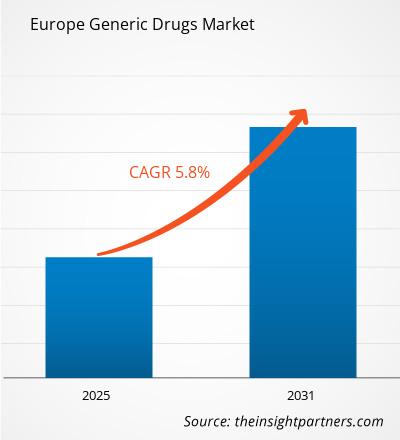欧洲仿制药市场规模预计将从2024年的779.596亿美元增至2031年的1140.3233亿美元。预计2025年至2031年期间,该市场的复合年增长率将达到5.8%。生物仿制药的扩张可能会在预测期内带来新的市场趋势。
欧洲仿制药市场分析
欧洲在全球仿制药市场中的地位得益于其成熟的制药行业,该行业生产价格合理的品牌药替代品。这些因素降低了医疗成本,并改善了该地区获得基本治疗的渠道。患者受益于更广泛的经济有效的治疗方案,从而增强了公共医疗体系。然而,与西欧相比,东欧国家往往面临与药物获取和监管延迟相关的挑战。
包括加快审批程序和生物仿制药开发激励措施在内的扶持性监管政策正在推动市场增长。此外,制药技术的进步以及对复杂仿制药投资的增加预计将带来新的市场机遇。
欧洲仿制药市场概况
欧洲仿制药市场的增长归因于日益加重的慢性病负担、对经济实惠的治疗方案的需求不断增长、政府政策以及对仿制药的监管支持。在欧洲国家中,德国是增长最快的仿制药市场。政府对仿制药的大力支持、高昂的医疗保健支出以及对平价疗法日益增长的需求,共同推动了这一快速增长。
您可以免费定制任何报告,包括本报告的部分内容、国家级分析、Excel 数据包,以及为初创企业和大学提供优惠和折扣
欧洲仿制药市场:

- 获取此报告的顶级关键市场趋势。此免费样品将包括数据分析,从市场趋势到估计和预测。
欧洲仿制药市场驱动因素和机遇
慢性病负担不断增加,对经济有效治疗的需求不断增加
欧洲正面临非传染性疾病(NCD)患病率上升的局面。每6人中就有1人在70岁之前死于这些疾病,其中心血管疾病、癌症、糖尿病和慢性呼吸系统疾病是主要诱因。根据世界卫生组织(WHO)的数据,截至2024年7月,该地区约有6400万成年人和约30万儿童及青少年患有糖尿病,其中三分之一的病例未被诊断出来。到2045年,每10个欧洲人中就有1人可能患有糖尿病,而欧洲目前已是全球1型糖尿病负担最重的国家。此外,WHO报告称,2022年欧洲新增糖尿病病例超过447万例,癌症相关死亡人数约200万例。
根据经济合作与发展组织(OECD)于2025年2月发布的一项针对欧盟(EU)成员国(例如法国、西班牙、荷兰、罗马尼亚和葡萄牙)的研究,这些国家中超过70%患有多种慢性病的患者至少需要服用三种药物,超过三分之一的患者需要服用四种或四种以上药物。法国和捷克共和国患有两种或两种以上慢性病(包括精神健康问题)的患者比例最高,分别为77.24%和70.13%。
欧洲慢性病发病率的飙升,促使医疗保健系统和患者寻求经济实惠的解决方案来管理长期疾病。仿制药是品牌药的经济实惠的替代品,对医疗保健提供者和患者而言极具吸引力。根据仿制药和生物类似药倡议组织的数据,在欧洲,仿制药的价格通常比品牌药便宜20%至80%,从而节省了大量成本。67%的处方药是仿制药,但这仅占药品总支出的29%。如果没有仿制药制造商的竞争,维持这种水平的可及性将使欧洲每年额外花费1138.2亿美元(1000亿欧元)。
根据欧洲制药工业协会联合会 (EFPIA) 2025 年发表的一篇文章,匈牙利、克罗地亚、罗马尼亚、拉脱维亚和保加利亚的人均癌症支出不到 169.75 美元(150 欧元),而德国和瑞士的人均癌症支出则超过 452.68 美元(400 欧元)。癌症治疗生物制剂的高昂成本促使人们采用生物仿制药,因为生物仿制药是市场上相对经济实惠的选择。据世界卫生组织称,生物仿制药比参考药物便宜约 60%。因此,日益加重的慢性病负担促使人们更多地采用经济实惠的仿制药进行治疗,从而推动市场增长。
专利到期日不断增加,市场独占机会不断丧失
在欧盟,药品专利的有效期通常为20年。然而,由于监管审批程序冗长,该期限通常会通过补充保护证书(SPC)进行延长,最长可达5年;如果进行儿科研究,还可额外延长6个月。此延长弥补了审批过程中耗费的时间,从而延长了原研药的市场独占期。这些保护期到期后,仿制药生产商有机会生产和销售生物等效的药物,从而加剧竞争并降低价格。在欧洲,2024年,多个治疗领域的多种药物的独占期到期。到期的药物包括卡博替尼(Cabometyx)和扎维塞夫塔(Zavicefta)等知名药物,以及泰瑞沙(Tagrisso)等创新疗法。减肥药(例如Saxenda)的专利到期促使梯瓦(Teva)和Hikma Pharmaceuticals等公司推出了仿制药。预计此举将降低价格并提高药物的可及性。
为仿制药创造更多空间的值得注意的药物包括:
- Abilify Maintenancea(大冢制药)是一种注射用抗精神病药物,2022 年的销售额将达到 155 亿美元,但该药物已于 2024 年 10 月失去专利。
- Farxiga(阿斯利康)是一种抗糖尿病药物,每年创造约 43 亿美元的收入,但于 2024 年失去了专利。
- 用于治疗癌症的 Lynparza(阿斯利康)销售额约为 27 亿美元,预计将于 2024 年至 2029 年间失去专利。
- Komboglyze/Kombiglyze XR(阿斯利康)是一种用于治疗 2 型糖尿病的缓释片,将于 2025 年失去专利。
- Entresto(沙库巴曲/缬沙坦)的组合专利预计将于 2025 年 7 月在欧洲到期。
- Latuda(Sunovion Pharmaceuticals)是一种抗精神病药物,销售额达 18 亿美元,于 2024 年 2 月失去专利。
- 抗凝剂 Xarelto(利伐沙班)正在失去专利保护,其主要专利将于 2026 年到期。
- 胃肠道药物 Xifaxan(Salix Pharmaceuticals)预计将于 2029 年 2 月在欧洲失去专利。
不同国家/地区的专利到期日期可能有所不同。在欧洲国家/地区,专利通常在申请日后20年到期。但是,也存在例外情况和延期,尤其是对于通过补充保护证书(SPC)获得的药品和植物保护产品。这些SPC可以延长专利期限,以弥补获得监管部门批准的延误。这些药品的到期为仿制药制造商创造了开发更具成本效益的替代品的机会。预计这种独占权的丧失将扩大仿制药和生物仿制药的市场份额,从而降低欧洲的医疗保健成本。
2025-26年,默克公司开发的用于癌症免疫疗法的Keytruda(2024年销售额超过250亿美元)和诺和诺德公司生产的用于糖尿病和减肥治疗的Ozempic将失去其专利。专利到期将为仿制药和生物类似药带来新的机遇。其他高收入药物,例如百时美施贵宝的血液稀释剂Eliquis和诺华的免疫学药物Cosentyx,也面临类似的专利到期,这扩大了仿制药的市场机会。预计此类药物专利到期将大幅推动仿制药和生物类似药的普及。
欧洲仿制药市场报告细分分析
有助于得出欧洲仿制药市场分析的关键部分是产品类型、技术、应用和最终用户。
- 根据产品类型,欧洲仿制药市场分为小分子药物(氟尿嘧啶 (5-FU)、甲氨蝶呤、阿霉素、丝裂霉素、天冬酰胺酶、卡铂、卡培他滨等)和生物仿制药。2024 年,小分子药物在欧洲仿制药市场占据较大份额。
- 按药物类别划分,欧洲仿制药市场细分为中枢神经系统、心血管、泌尿科、风湿病、肿瘤科、血液科及其他。2024年,其他类别占据了欧洲仿制药市场的最大份额。
- 根据给药途径,欧洲仿制药市场分为口服、注射、外用和其他。2024年,口服药物在欧洲仿制药市场中占据最大份额。
- 根据类型,市场分为处方药和非处方药。2024年,处方药在欧洲仿制药市场占据较大份额。
- 根据分销渠道,市场细分为医院药房、零售药房和在线药房。2024年,医院药房占据了欧洲仿制药市场的最大份额。
欧洲仿制药市场份额(按地区)分析
欧洲仿制药市场报告涵盖德国、英国、法国、意大利、西班牙、波兰、北欧地区以及其他欧洲国家。得益于欧盟严格的监管和生物制剂的进步,欧洲市场正在经历强劲增长。德国在创新方面处于领先地位,英国和法国的研发实力雄厚,而意大利和西班牙则不断拓展临床应用,共同推动着市场扩张。
推动德国市场增长的主要因素包括医疗成本上涨、政府大力推广仿制药,以及患者对平价药品的需求不断增长。德国致力于削减公共医疗支出,并致力于提高高质量治疗的可及性,这推动了仿制药的普及。
欧洲仿制药市场区域洞察
Insight Partners 的分析师已详尽阐述了预测期内影响欧洲仿制药市场的区域趋势和因素。本节还讨论了欧洲仿制药市场的各个细分市场,涵盖北美、欧洲、亚太地区、中东和非洲以及南美和中美洲。

- 获取欧洲仿制药市场的区域特定数据
欧洲仿制药市场报告范围
| 报告属性 | 细节 |
|---|---|
| 2024年的市场规模 | 779.596亿美元 |
| 2031年的市场规模 | 1140.3233亿美元 |
| 全球复合年增长率(2025-2031) | 5.8% |
| 史料 | 2021-2023 |
| 预测期 | 2025-2031 |
| 涵盖的领域 | 按产品类型
|
| 覆盖地区和国家 | 欧洲
|
| 市场领导者和主要公司简介 |
|
欧洲仿制药市场参与者密度:了解其对商业动态的影响
欧洲仿制药市场正在快速增长,这得益于终端用户需求的不断增长,而这些需求的驱动因素包括消费者偏好的演变、技术进步以及对产品优势的认知度的提升。随着需求的增长,企业正在扩展产品线,不断创新以满足消费者需求,并抓住新兴趋势,从而进一步推动市场增长。
市场参与者密度是指特定市场或行业内企业或公司的分布情况。它表明特定市场空间内竞争对手(市场参与者)的数量相对于其规模或总市值而言。
在欧洲仿制药市场运营的主要公司有:
- 盖氏制药公司
- 赢创工业股份公司
- BioHorizons公司
- 诺贝尔生物护理服务公司
- UBGEN
- B&B 牙科植入公司
免责声明:以上列出的公司没有按照任何特定顺序排列。

- 获取欧洲仿制药市场顶级关键参与者概览
欧洲仿制药市场新闻及最新发展
欧洲仿制药市场评估通过收集一手和二手研究的定性和定量数据进行,这些数据包括重要的企业出版物、协会数据和数据库。以下是欧洲仿制药市场的一些关键发展:
- 太阳制药工业公司(Sun Pharmaceutical Industries)和太郎制药工业公司(Taro Pharmaceutical Industries)同意合并,太阳制药工业公司以每股43美元的价格收购太郎制药工业公司(Taro Pharmaceutical Industries)的流通股,总价3.48亿美元。太阳制药工业公司目前已持有仿制药和非处方药制造商太郎制药78.5%的股份,预计合并将于2024年上半年完成。
- 艾伯维在欧盟推出PRODUODOPA(foslevodopa/foscarbidopa),用于治疗患有严重运动波动和不自主运动的晚期帕金森病患者。该疗法旨在治疗目前帕金森病药物疗效不佳的病例。
欧洲仿制药市场报告覆盖范围和交付成果
《欧洲仿制药市场规模和预测(2021-2031)》报告对以下领域进行了详细的市场分析:
- 欧洲仿制药市场规模以及区域和国家层面涵盖的所有主要细分市场的预测。
- 欧洲仿制药市场趋势以及驱动因素、限制因素和关键机遇等市场动态。
- 详细的 PEST 和 SWOT 分析。
- 欧洲仿制药市场分析涵盖主要市场趋势、全球和区域框架、主要参与者、法规和最新市场发展。
- 行业格局和竞争分析涵盖市场集中度、热图分析、知名参与者以及欧洲仿制药市场的最新发展。
- 详细的公司简介。
- 历史分析(2 年)、基准年、预测(7 年)及复合年增长率
- PEST 和 SWOT 分析
- 市场规模价值/数量 - 全球、区域、国家
- 行业和竞争格局
- Excel 数据集



Report Coverage
Revenue forecast, Company Analysis, Industry landscape, Growth factors, and Trends

Segment Covered
This text is related
to segments covered.

Regional Scope
North America, Europe, Asia Pacific, Middle East & Africa, South & Central America

Country Scope
This text is related
to country scope.
常见问题
The market is expected to register a CAGR of 5.8% during 2025–2031.
The Europe Generic Drugs market value is expected to reach US$ 114032.33 million by 2031.
Teva Pharmaceutical Industries Ltd, Viatris Inc, Sandoz Group AG, STADA Arzneimittel AG, and Sun Pharmaceutical Industries Ltd. are among the key players operating in the market.
The Expansion of Biosimilars is likely to emerge as a new growth trend in the market in the coming years.
The Rising Chronic Disease Burden and Increasing Demand for Cost-Effective Treatments and Government Policies and Regulatory Support for Generics are among the significant factors fueling the market growth.
Germany dominated the market in 2024.
The List of Companies - Europe Generic Drugs Market
- Teva Pharmaceutical Industries
- Viatris Inc
- Dr. Reddy's Laboratories Ltd
- Novartis AG
- Sun Pharmaceutical Industries Ltd
- AbbVie Inc, AstraZeneca Plc
- Sanofi SA
- Aurobindo Pharma Ltd
- Glenmark Pharmaceuticals Ltd
- Hikma Pharmaceuticals Plc
- Cipla Ltd
- GSK Plc
- Eli Lilly and Co
- medac Pharma LLP
- Lupin Ltd
The Insight Partners performs research in 4 major stages: Data Collection & Secondary Research, Primary Research, Data Analysis and Data Triangulation & Final Review.
- Data Collection and Secondary Research:
As a market research and consulting firm operating from a decade, we have published and advised several client across the globe. First step for any study will start with an assessment of currently available data and insights from existing reports. Further, historical and current market information is collected from Investor Presentations, Annual Reports, SEC Filings, etc., and other information related to company’s performance and market positioning are gathered from Paid Databases (Factiva, Hoovers, and Reuters) and various other publications available in public domain.
Several associations trade associates, technical forums, institutes, societies and organization are accessed to gain technical as well as market related insights through their publications such as research papers, blogs and press releases related to the studies are referred to get cues about the market. Further, white papers, journals, magazines, and other news articles published in last 3 years are scrutinized and analyzed to understand the current market trends.
- Primary Research:
The primarily interview analysis comprise of data obtained from industry participants interview and answers to survey questions gathered by in-house primary team.
For primary research, interviews are conducted with industry experts/CEOs/Marketing Managers/VPs/Subject Matter Experts from both demand and supply side to get a 360-degree view of the market. The primary team conducts several interviews based on the complexity of the markets to understand the various market trends and dynamics which makes research more credible and precise.
A typical research interview fulfils the following functions:
- Provides first-hand information on the market size, market trends, growth trends, competitive landscape, and outlook
- Validates and strengthens in-house secondary research findings
- Develops the analysis team’s expertise and market understanding
Primary research involves email interactions and telephone interviews for each market, category, segment, and sub-segment across geographies. The participants who typically take part in such a process include, but are not limited to:
- Industry participants: VPs, business development managers, market intelligence managers and national sales managers
- Outside experts: Valuation experts, research analysts and key opinion leaders specializing in the electronics and semiconductor industry.
Below is the breakup of our primary respondents by company, designation, and region:

Once we receive the confirmation from primary research sources or primary respondents, we finalize the base year market estimation and forecast the data as per the macroeconomic and microeconomic factors assessed during data collection.
- Data Analysis:
Once data is validated through both secondary as well as primary respondents, we finalize the market estimations by hypothesis formulation and factor analysis at regional and country level.
- Macro-Economic Factor Analysis:
We analyse macroeconomic indicators such the gross domestic product (GDP), increase in the demand for goods and services across industries, technological advancement, regional economic growth, governmental policies, the influence of COVID-19, PEST analysis, and other aspects. This analysis aids in setting benchmarks for various nations/regions and approximating market splits. Additionally, the general trend of the aforementioned components aid in determining the market's development possibilities.
- Country Level Data:
Various factors that are especially aligned to the country are taken into account to determine the market size for a certain area and country, including the presence of vendors, such as headquarters and offices, the country's GDP, demand patterns, and industry growth. To comprehend the market dynamics for the nation, a number of growth variables, inhibitors, application areas, and current market trends are researched. The aforementioned elements aid in determining the country's overall market's growth potential.
- Company Profile:
The “Table of Contents” is formulated by listing and analyzing more than 25 - 30 companies operating in the market ecosystem across geographies. However, we profile only 10 companies as a standard practice in our syndicate reports. These 10 companies comprise leading, emerging, and regional players. Nonetheless, our analysis is not restricted to the 10 listed companies, we also analyze other companies present in the market to develop a holistic view and understand the prevailing trends. The “Company Profiles” section in the report covers key facts, business description, products & services, financial information, SWOT analysis, and key developments. The financial information presented is extracted from the annual reports and official documents of the publicly listed companies. Upon collecting the information for the sections of respective companies, we verify them via various primary sources and then compile the data in respective company profiles. The company level information helps us in deriving the base number as well as in forecasting the market size.
- Developing Base Number:
Aggregation of sales statistics (2020-2022) and macro-economic factor, and other secondary and primary research insights are utilized to arrive at base number and related market shares for 2022. The data gaps are identified in this step and relevant market data is analyzed, collected from paid primary interviews or databases. On finalizing the base year market size, forecasts are developed on the basis of macro-economic, industry and market growth factors and company level analysis.
- Data Triangulation and Final Review:
The market findings and base year market size calculations are validated from supply as well as demand side. Demand side validations are based on macro-economic factor analysis and benchmarks for respective regions and countries. In case of supply side validations, revenues of major companies are estimated (in case not available) based on industry benchmark, approximate number of employees, product portfolio, and primary interviews revenues are gathered. Further revenue from target product/service segment is assessed to avoid overshooting of market statistics. In case of heavy deviations between supply and demand side values, all thes steps are repeated to achieve synchronization.
We follow an iterative model, wherein we share our research findings with Subject Matter Experts (SME’s) and Key Opinion Leaders (KOLs) until consensus view of the market is not formulated – this model negates any drastic deviation in the opinions of experts. Only validated and universally acceptable research findings are quoted in our reports.
We have important check points that we use to validate our research findings – which we call – data triangulation, where we validate the information, we generate from secondary sources with primary interviews and then we re-validate with our internal data bases and Subject matter experts. This comprehensive model enables us to deliver high quality, reliable data in shortest possible time.

 获取此报告的免费样本
获取此报告的免费样本